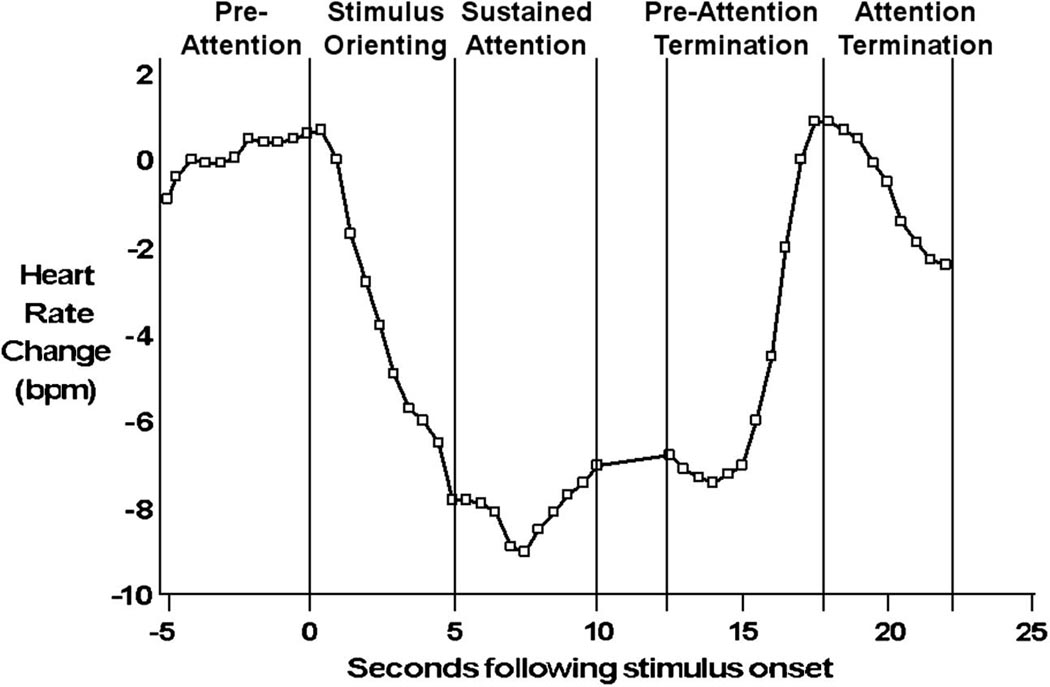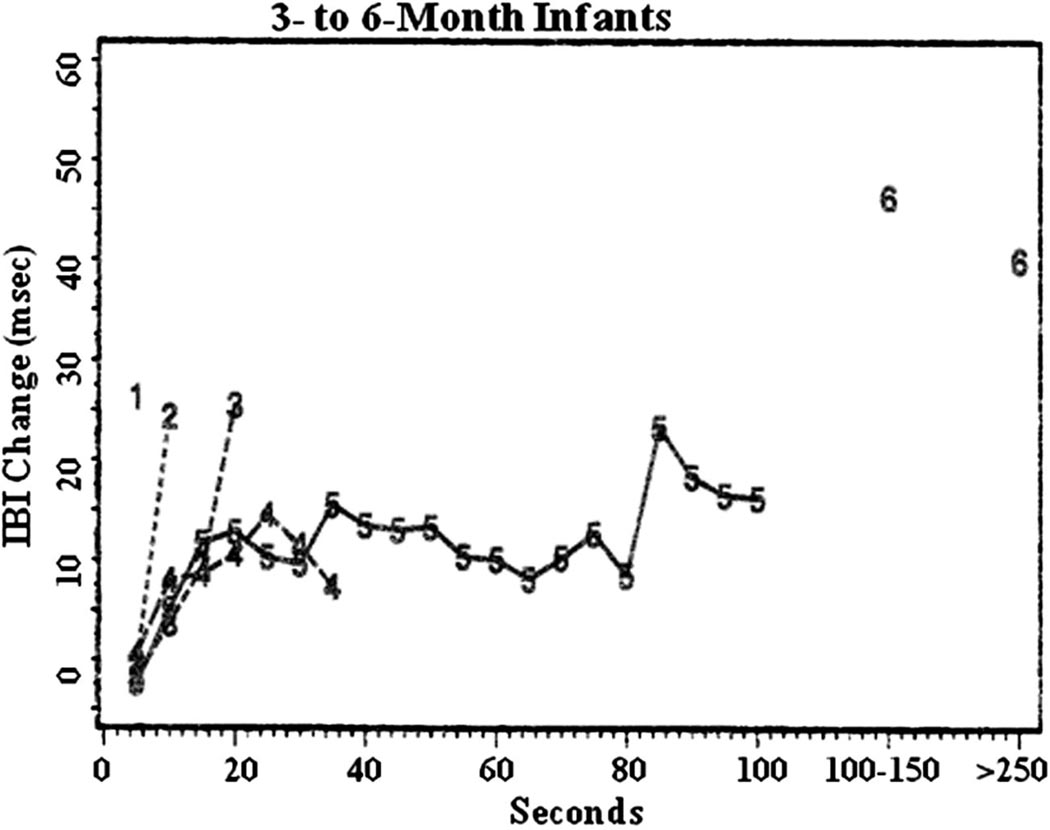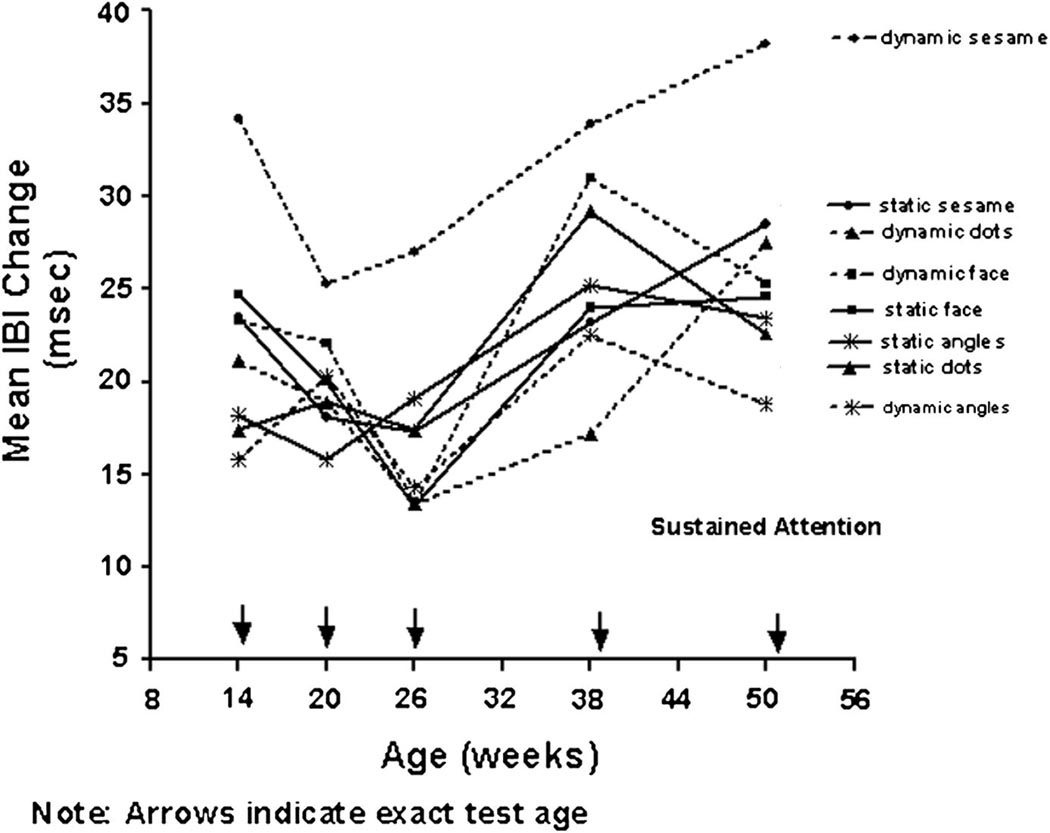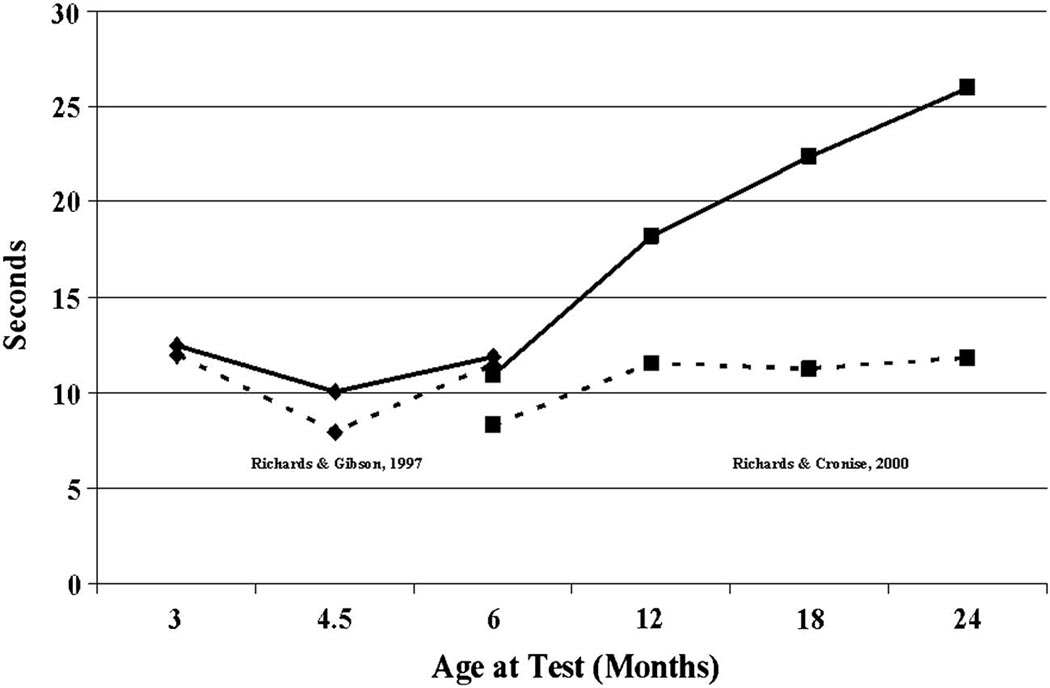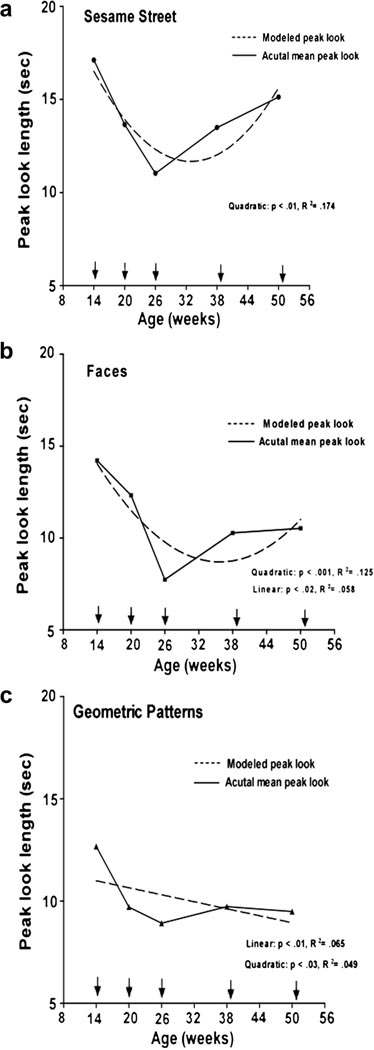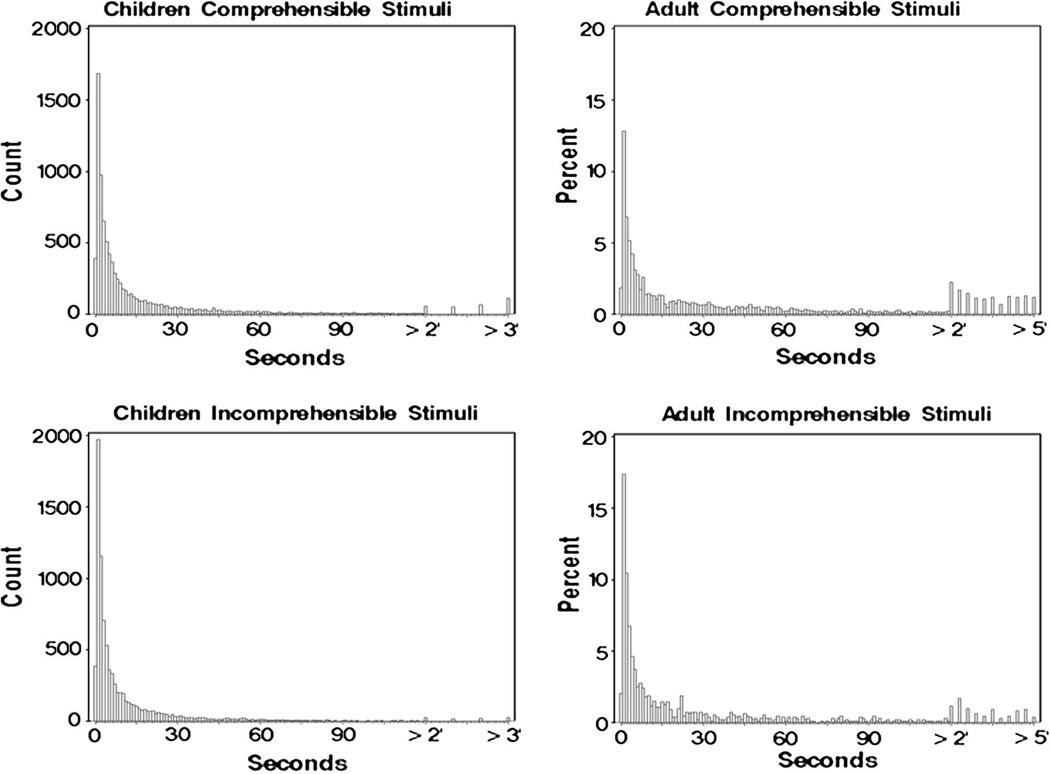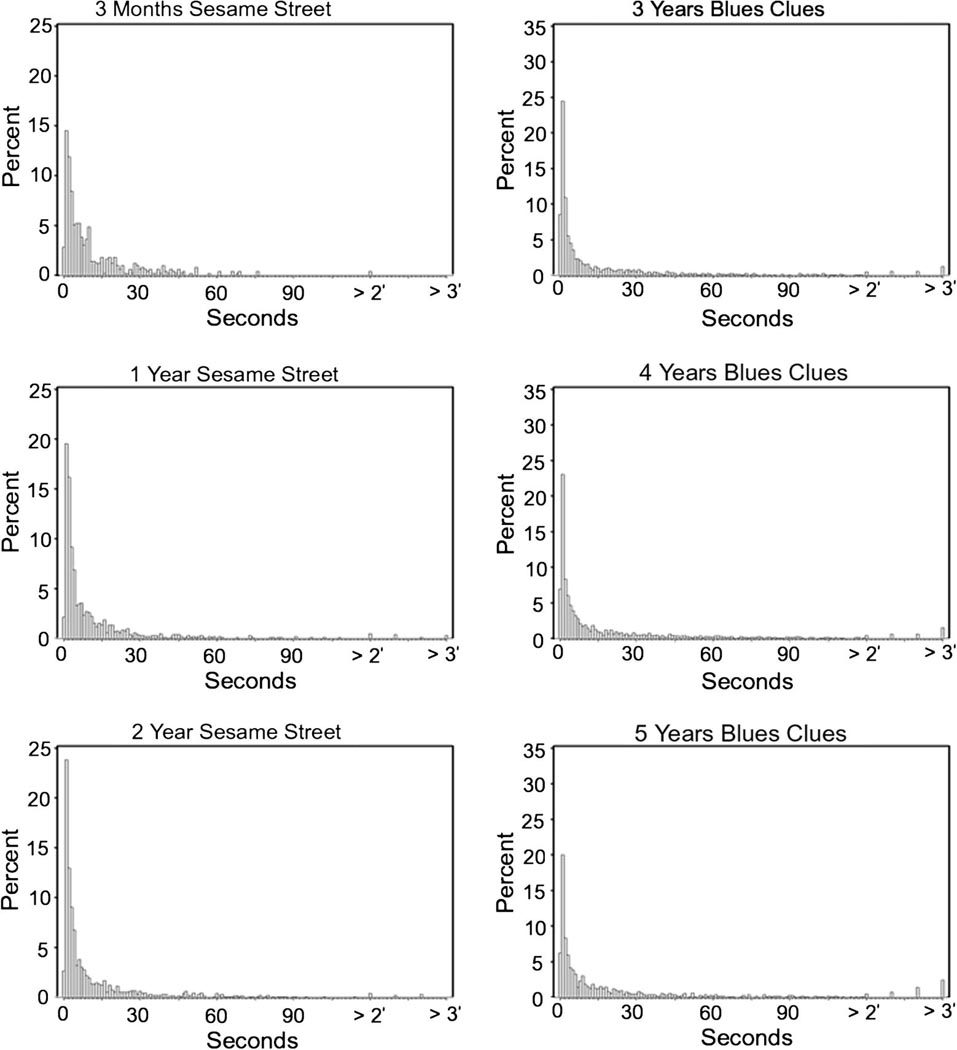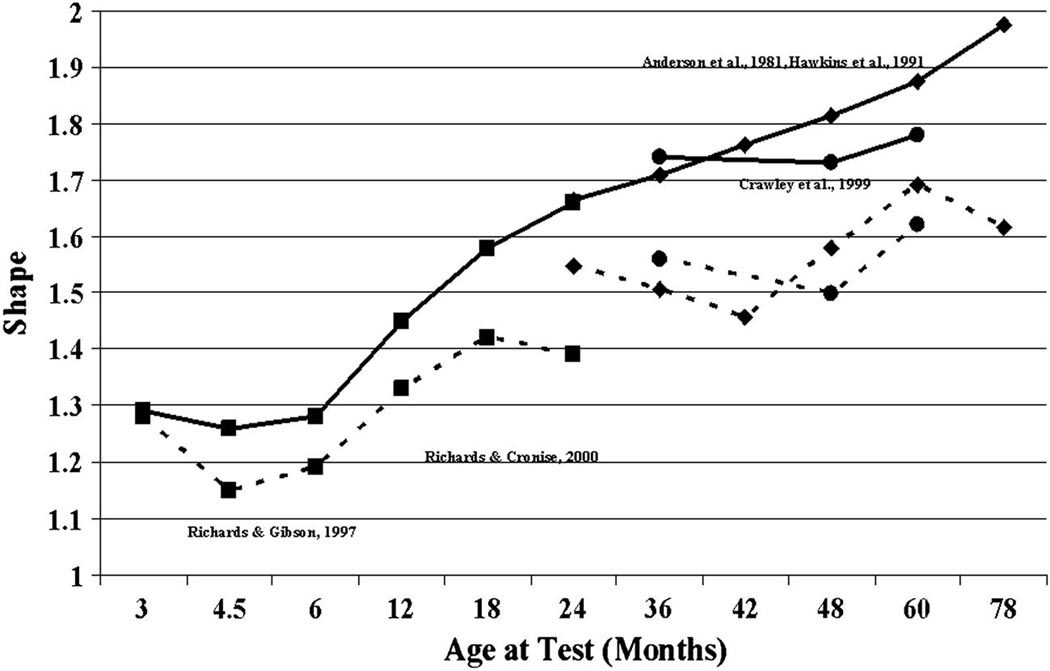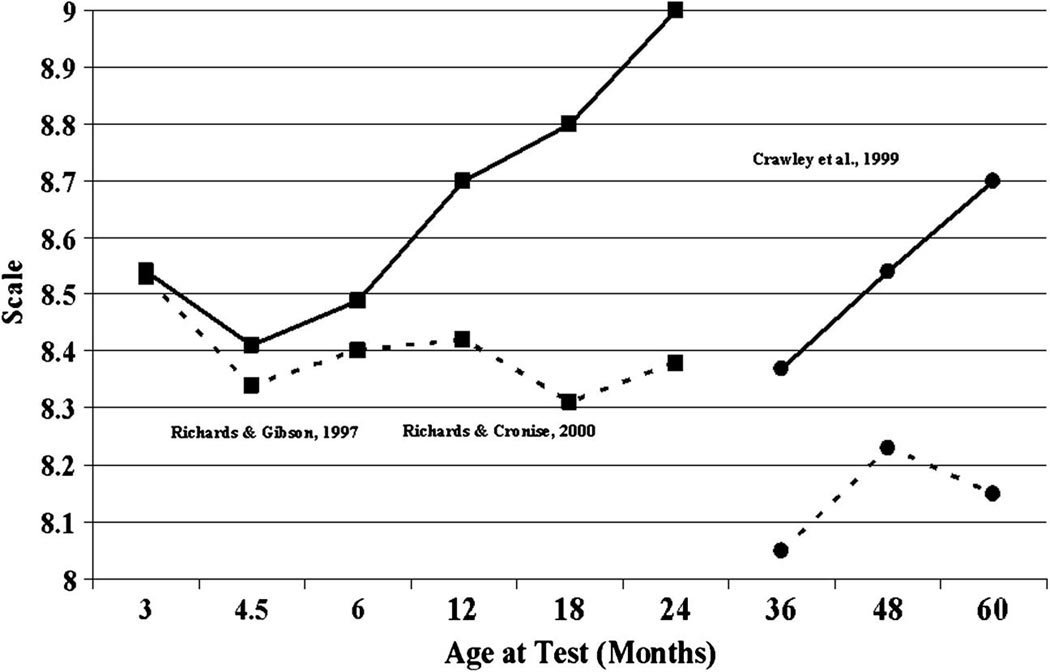Abstract
The study of visual attention in infants has used presentation of single simple stimuli, multi-dimensional stimuli, and complex dynamic video presentations. There are both continuities and discontinuities in the findings on attention and attentiveness to stimulus complexity. A continuity is a pattern of looking that is found in the early part of infancy that remains throughout adulthood. A discontinuity is an emerging sensitivity to the content of the information in the stimulus presentations and alterations in patterns of attention based upon stimulus comprehensibility. The current paper reviews some of these findings with particular application to complex video presentations.
The study of visual attention in infants has used presentations of a wide range of stimuli. The first decades of this work used simple geometric patterns in an attempt to study basic process and the development of attention. These stimuli were simple static geometric patterns or simple pictures of objects and people. The goal of this work was to characterize basic processes in infant attention and simple stimuli were used to reduce the effect of non-cognitive processes, such as social factors (faces, interpersonal social exchanges) or specific experiences of the infant (familiar or home surroundings). However, in the last few years it has been shown that the use of such stimuli might not generalize to the types of stimulus information found in the infant’s environment. This has led to the use of “complex” stimuli, the use of dynamic visual patterns, and the study of attention to video programs played on television monitors.
The current paper will review work using visual fixation and heart rate changes as measures of attention to visual stimuli. I will emphasize the work done in my own laboratory vis-a-vis some general work done on visual attention. This work shows both continuity from infants to adults on basic visual processes and work done with complex video stimuli, and discontinuity in attention to these types of stimuli.
Early work using simple stimuli
The first work on infant visual attention examined the length of time that infants would direct their fixation to simple visual stimuli. These stimuli were typically presented on rear-projection screens with slide projectors, were achromatic, and included everything from pictures of faces, checkerboard patterns and geometric shapes, landscape scenes, to pictures of realistic objects. Because of the nature of the stimulus projection device, these pictures were “static” presentations, with no movement in the parts of the stimuli and no movement of stimuli on the projection screen. The duration of fixation towards the presentation device became the de facto measure of infant visual attention. It was noticed very early in this research that the patterns of looking behavior changed significantly over the first two years of postnatal life. With increases in age, infants paid attention to patterns for longer periods of time and attended to increasing amounts of visual complexity.
The stimuli that came to be used for the study of visual attention were simple geometric patterns—perhaps the most frequent was a simple checkerboard pattern. I think this use of simple geometric patterns was a result of two trends. First, there was an attempt to be scientific and study basic processes of attention without the effect of non-cognitive factors such as faces, social interactions, or familiar environments. For example, Karmel and Maisel (1975) developed a model for infant visual attention that described how long a stimulus would elicit attention. This model was based on the complexity of the stimulus and the relation between stimulus complexity and the brain areas involved in visual perception. A match between the amount of stimulus information (“complexity”) and the brain areas supporting visual perception should elicit a more attention (“long fixation times”), whereas a mismatch would lead to less attention (“short fixation times”). Thus, an important aspect of stimuli in developmental visual attention work would be to be able to measure the amount of stimulus complexity. Simple geometric patterns could be easily quantified. They also did not have “non-cognitive” aspects, such as a familiar face, gender, and so forth.
A second reason for the popularity of the use of simple geometric patterns was Cohen’s seminal study that distinguished differing types of attention using behavioural measures (Cohen, 1972). I have recently reviewed this work and the influence that Cohen’s work had on the study of infant visual attention (Richards, 2009). Cohen introduced an important methodological advance he called the “infant-controlled” presentation procedure (cf. Horowitz, Paden, Bhana & Self, 1972). . The visual patterns were presented for as long as the infant was looking, and when the infant looked away, the pattern was turned off. This was an improved measure of attention over the “fixed interval” presentation procedure because it did not confound patterns of looking (and looking away) with the infant’s transitory fixations. The most exciting part of this study was the distinction between “attention-getting” and “attention-holding” as separable cognitive processes. This allows the distinction between how stimulus characteristics would elicit attention to the stimulus and draw fixation towards it; and how stimulus characteristics might keep attention for some length of time on the stimulus. Cohen in this study used checkerboard patterns of varying size and density and showed that the characteristics of stimulus complexity that affected attention-getting were different than those that affected attention-holding.
These types of studies dominated the first three decades of research on infant visual attention. Although other types of stimuli were used, and some were what I will later call “complex” stimuli, these were not done in the subspecialty that was specifically studying attention. Research on auditory stimuli lagged in quantity behind research on visual attention, and used primarily pure tone stimuli.
Measuring attention more complexly
The research on visual attention to these simple stimuli used fixation directed to the stimuli as the measure of attention. Or rather, the measure was how long the eyes were pointed in the direction of the presentation device; be it a rear projection slide projector, television or computer monitor, or 2- or 3-D presentations of stimuli. The use of fixation duration assumed that central attentional processes were isomorphic and isotemporal with the overt measure of fixation behaviour. The suggestion of Cohen that even simple geometric achromatic checkerboard patterns may elicit separable cognitive processes was interesting. But separating these cognitive processes was difficult.
However, one measure that may be useful in distinguishing these components of attention is heart rate changes that occur during visual fixation. A number of studies in the 1970’s and 1980’s used heart rate as a dependent variable to index infants’ attention responses to simple auditory stimuli (e.g., Graham, 1970, 1979, 1992; Graham, Anthony, & Zeigler, 1983). This was based on Sokolov’s (Sokolov, 1963) assertion that heart rate changes might be a useful index of the orienting response. Porges (1976, 1980) began using heart rate in response to visual stimuli presented for longer periods of time; using, presentations of simple static stimuli. Even with simple stimuli, he suggested that there could be a sustained lowering (deceleration) of heart rate after the initial phases of stimulus orienting, and that heart rate might be a used measure of “attention-holding” or longer-term cognitive processing.
I began to use heart rate with the specific goal to study the more extended aspects of stimulus processing with the infant control procedure (1987). Infants were presented with simple static geometric stimuli and the heart rate response was measured while the infant looked toward the stimulus. There was a ubiquitous pattern of heart rate change in response to these stimuli. Figure 1 shows the heart rate change from young infants when viewing simple geometric visual patterns (Richards & Casey, 1981). These stimuli were simple achromatic geometric patterns presented on a computer monitor. There is a large deceleration of heart rate at the beginning of the fixation towards the stimulus. This is followed by a sustained lowered heart rate for a variable duration of time, and the return of heart rate to its prestimulus level. The results in Figure 1 are taken only from when the infant is looking toward the stimulus. I developed a model that stated that the period of time when the heart rate change is lowered is temporally contiguous with central attentional processes, and have reviewed this work in several places (Richards, 2010; Richards & Casey, 1992; Reynolds & Richards, 2007).
Figure 1.
The heart-rate-defined phases of attention in 3 to 6 month old infants. (Richards & Casey, 1991).
The first use of this model of heart-rate-linked attention processes was done with the stimuli borrowed from work at that time. My dissertation was based on Cohen’s (1972) work but using heart rate as an additional measure of infant attention to distinguish attention-getting and attention-holding (Richards, 1985). Following this, I did several studies using geometric patterns, including checkerboards, stars, shapes, patterns; all achromatic stimuli, and without sound. I used computer-based video displays so I could integrate online measures of heart rate with stimulus presentation parameters (e.g., Richards, 1987; see review, Richards & Casey, 1992). Using computer-based video presentations, I was able to present “dynamic” stimuli. These dynamic stimuli consisted of the sequential presentation of a series of “static” stimuli but which changed slightly in shape, position, or shading. This produced dynamic changes in the screen presentation. We found in several studies that infant’s fixations and heart rate changes indicated more attentiveness to dynamic stimuli than to static stimuli (e.g., Hicks & Richards, 1998; also see Shaddy & Colombo, 2004). So even using simple achromatic stimuli, adding some dynamic properties to the display affected the quality and duration of visual attention.
Direct comparisons between simple stimuli and video movie presentations
A “historical accident” that changed my research procedures was the onset of the “Laserdisc” video system. The “Laserdisc” video system presented video movies on television monitors; the “Laserdisc” player was a forerunner to compact-disc and DVD movies and allowed random access to a movie. One of the earliest movies we had in my family was the “Sesame Street” movie, “Follow that Bird”. We began to use this stimulus between trials to attract fixation, keep infants from “fussing out” of experiments with simple geometric patterns, and to engage the arousal level of the infant. At one point I became familiar with Dan Anderson’s studies of Sesame Street viewing in young children (e.g. Anderson & Levin, 1979; Anderson, Lorch, Field, & Sanders, 1981) and realized that I had the ability to do computer-controlled studies of presentations of “video movie” material.
My first studies to address the question of attention to complex stimuli were done by presenting infants (3 to 6 months) with recordings of Sesame Street’s “Follow that Bird” and with dynamic computer-generated audiovisual stimuli. This was done first with infants from 3, 4.5, and 6 months of age (Richards & Cronise, 200), and then with infants at 6, 12, 18, and 24 months of age (Richards & Gibson, 2001). There were two questions that were addressed in these studies. First, we (Richards & Gibson, 1997) wanted to see if the heart rate changes found to simple static and dynamic stimuli were sustained over the long periods of time that infants would watch the Sesame Street movie. Infants were presented in one session with an extended recording of “Follow that Bird”. Heart rate and looking toward the video monitor were recorded. Infants were presented in a second session with dynamic computer-generated visual stimuli, e.g., a series of concentric circles, a rotating star, a flashing checkerboard pattern. The computer-generated visual stimuli were `synchronized with computer-generated audio stimuli. Figure 2 shows the heart rate (inter-beat interval, reciprocal of heart rate) changes at stimulus onset and as long as the infant was looking toward the video monitor. This figure shows short-latency changes associated with short looks, and an increasingly sustained heart rate change for longer looks (> 40 s) and continued sustained heart rate changes for the longest looks (> 50s). The heart rate changes elicited during the computer-generated stimuli were similar to those elicited by the Sesame Street movie. This suggests that at this age that both the computer-generated and video presentations elicit similar types of sustained attention.
Figure 2.
Heart rate changes in infants from 3 to 6 months during looks toward complex audiovisual stimuli (Richards & Gibson, 1997). The data are plotted as changes in interbeat-intervals (IBI change), with longer IBIs reflecting a deceleration of heart rate. The lines are separated by look lengths (1: 0–5s; 2: 5–10s; 3: 10–20s; 4: 20–40s 5: > 40s; 6: 100–150 and 200 s).
The second study (Richards & Cronise, 2000) extended this study to older infants. We used the same stimuli and presentation procedures, but did this for infants at age 6, 12, 18, or 24 months of age. This age range was chosen specifically because 24 months represented the youngest age typically studied in children’s TV program viewing (e.g.,Anderson et al., 1981). There were two findings in that study of interest to the present section. First, we found as with the youngest infants that there was a regular relationship between the extended viewing and the heart rate change. The type of heart rate change shown in Figure 2 for young infants was found in older infants (see Figure 5 in Richards & Anderson, 2004). Second, we found a differential amount of viewing time for the two types of stimuli at older ages but not younger ages. Figure 3 shows the average fixation times to the computer-generated patterns and the video program. This figure combines the results from Richards and Gibson (1997) with Richards and Cronise (2000). The average fixation times for the youngest ages was nearly identical for the computer-generated patterns and the “Sesame Street” video movie for all testing ages. However, there was an increasing differentiation after 6 months, with an increasing extended looking times for the video patterns at 12, 18, and 24 months of age (Figure 3).
Figure 5.
The mean amount of heart rate (interbeat interval) change during the phase of sustained attention for each of the stimulus types as a function of age. (From Courage, Reynolds, & Richards, 2006).
Figure 3.
Average look duration for the video (solid lines) and computer-generated complex (dashed lines) stimuli, separately for testing ages. (adapted from Richards & Anderson, 2004).
There are several points to be made about these studies. First, the heart rate changes found to very simple stimuli, found to pure-tone stimuli (Graham et al, 1970) and simple geometric patterns (Richards, 1987) are also found in more complex patterns. The complex stimuli in these studies had dynamic changes, multi-modal elements, and synchronized audio- and visual- modality changes. These more complex stimuli extend the heart rate deceleration change that is found for relatively simple stimuli. Second, the response to complex computer-generated abstract audio-visual patterns and “Sesame Street” video movies was not different at young ages, but began affect looking duration at later ages. We interpreted this difference as due to the “comprehensibility” of the movie stimuli for the older age infants and their increasing comprehension of language and social stimuli (Richards & Cronise, 2000). Third, while not obvious from the fixation data, we had very large extended fixations accompanied by a sustained heart rate deceleration for both younger and older infants. One could not imagine a 3- 6- or 12-month old infant looking at a static checkerboard pattern for 100 s in the infant control procedure. Yet, for these patterns we found a significant number of extremely long visual fixations. These fixations were accompanied by decelerations indicating that sustained attention engagement continued to increase across the duration of the extended fixation. However, these studies did not directly compare “simple” and “complex” stimuli, since simple static geometric patterns were not included in either study. Nor did they directly compare “comprehensible” and “incomprehensible” stimuli, since the computer-generated patterns differed on a number of dimensions from the Sesame Street video movie.
A more recent study directly compared a wide range of visual stimuli that varied on degree of complexity (Courage, Reynolds, & Richards, 2006). This study was motivated by two concerns relevant to the current paper. First, there is a large literature of research on infant looking times that show that look duration decreases over the age range from 3 months to 8 or 9 months of age. Colombo and colleagues presented a meta-analysis of studies with infants in the first year showing an increase in look duration from birth to 3 months followed by a steady decline from three to 7 months of age (Colombo, 2001; Colombo, Harlan, and Mitchell, 1999). They also showed a plateau in look duration from 7 months of age through one year of age. However, there are a number of findings that seem to show an increase in looking time in the second half of the first year of life, including the findings shown in Figure 3 from Richards and Cronise (2000). We hypothesized that the difference between the Colombo reviewed studies and others showing an increase in look fixation in the second half of the first year might be due to the Colombo review focusing on traditional “simple static” stimuli, or even simple stimuli with dynamic properties. To answer these questions four types of stimuli were presented to infants ranging in age from 3 months to 12 months of age. The types of stimuli were a video of a woman’s face, a computer-generated geometric pattern of white dots displayed on a black background in a diamond-shaped configuration, a second geometric pattern, or a clip from a Sesame Street movie, “Sesame Street’s 25th Anniversary Movie”. Each stimulus was presented either as a static still frame, or in a dynamic configuration (video playing as usual; geometric patterns presented sequentially to show dynamic movement; video of face while talking). All stimuli were presented on a computer monitor without sound. This study allowed a direct comparison between “static” and “dynamic” versions of the same stimuli, and “simple geometric patterns” compared to a person’s face, or the Sesame Street video presentation.
There were several results from this study relevant to this paper. Figure 4 shows the average looking time for the Sesame Street, faces, and geometric patterns, combined for static and dynamic stimuli. Consistent with the Colombo (2001; Colombo et al., 1999) model there was a decrease in looking time from 3 to 6 months of age for all three stimulus types. However, from 6 to 9 to 12 months, there was a steady increase in look duration for the Sesame Street stimuli, a moderate increase for the face stimuli, and a flat plateau for the geometric patterns. This suggests that the findings reported by Colombo in his meta-analysis were specific for the traditional geometric patterns used in infant attention research. Note also the differences in average looking time for the three stimulus types. Average look duration at 12 months were approximately 16 s for the Sesame Street stimuli, 12 s for the face stimuli, and < 10 s for the geometric patterns. Figure 5 shows the heart rate changes for the stimuli separate for the 8 stimuli (4 types X static, dynamic). The heart rate change to the dynamic Sesame Street stimuli was larger than the other stimuli, and showed an increasingly larger heart rate change from 4.5 months to 12 months of age. So, dynamic multi-modal video stimuli not only result in extended fixations, but there is increasing look duration changes to these and an increasingly larger amount of sustained attention.
Figure 4.
Peak look duration for faces, achromatic geometric patterns, and Sesame Street stimulus as a function of testing age. The dashed lines represent the best fitting multiple regression trend for the look data. (From Courage, Reynolds, & Richards, 2006).
There are both continuities and discontinuities in infant visual attention to simple and complex stimuli shown in these studies. One continuity is the heart rate change that occurs during extended visual fixation. The results presented in Figure 2 show that when a look becomes extended past 40 s in duration, there is a nearly identical pattern of heart rate changes for both “computer-generated” and “Sesame Street” stimuli. This does not change over the age range from 6 months to 2 years of age. This implies that a basic mechanism for the relation between attention and heart rate change exists early in infancy and continues throughout the infant years. There are, however, discontinuities in the developmental changes for simple and complex stimuli. Both simple static geometric patterns, dynamically presented geometric patterns, and computer-generated audio-visual patterns, do not reliably elicit long extended fixations after 6 months of age and this pattern apparently does not change through two years of age (e.g., Figure 3, Figure 4). Some process occurs around six months where video movies begin to attract extended fixations patterns to a larger degree and this increases from 6 months through two years. The heart rate changes seem to be linked to the extended fixations rather than to the type of stimulus. The probability that a complex computer-generated audiovisual pattern will elicit a long extended fixation is much lower than that of video movie stimuli. However, when a complex computer-generated audiovisual pattern elicits a very long fixation, there is an increasingly sustained attention engagement, and an increasingly extended heart rate change.
Comprehensibility as one factor affecting infant attention to video
The previous section reviewed findings showing that “complex” visual stimuli elicit more attention than “simple” visual stimuli. The difference between these stimuli becomes most obvious after 6 months of age. Three studies were reviewed that compared simple geometric stimuli, complex geometric stimuli, and Sesame Street video patterns. A discontinuity emerged after six months of age where video programs like “Sesame Street” movies begin to elicit longer periods of extended visual fixation and accompanying indices of increasingly enhanced sustained attention. I believe the discontinuity comes from the onset around six months of age of psychological processes that are sensitive to stimulus comprehensibility. The basic attention processes “serve” these high-level comprehension processes and result in such extended heart rate changes that we have found. However, the studies that I reviewed did not directly compare “comprehensible” and “incomprehensible” stimuli, since the computer-generated patterns differed on a number of dimensions from the Sesame Street video movie. I will review two unpublished studies in this section that show a large effect of video language comprehensibility on infant attention.
The first study studied infants at 6, 12, 18, and 24 months of age (Pempek, Kirkorian, Richards, Anderson, Lund, Stevens, 2009). Given the prior findings with infants in both audio-visual Sesame Street movie presentations (Richards & Cronise, 2000; Richards & Gibson, 2001), it was expected that across this age range there would be a change in the sensitivity to the elements of comprehensibility. The infants were presented with scenes from the “Teletubbies” TV show. This show, like Sesame Street TV program, has human and non-human characters with action, singing, and has a specific educational purpose. Two groups were used and each group was presented with 6 minute segments that alternated between the normal program and a program thought to restrict comprehensibility. One of the “incomprehensible” programs presented randomly sequenced clips from the television program so the content and educational objectives were unordered (“random”). The second “incomprehensible” program modified the audio track by reversing the sound track on a word-by-word basis (“backward speech”). These manipulations reduce the sequential comprehensibility of the television program, or the linguistic comprehensibility, respectively. The looks toward the monitor were coded and heart rate was recorded.
There were two interesting findings from this study. First, there were almost no differences in looking time for the normal and two distorted versions of the “Teletubbies” video for the youngest two ages in this study. Both the average duration of looking and the presence of long extended looks during the viewing sessions were the same. Differences began to appear at 18 months of age, and were stronger at 24 months of age. First, at both 18 and 24 months of age, infants that saw the normal video first looked significantly longer at the normal video than at the subsequent distorted video, regardless of the distortion (random, backward speech). Infants who saw the videos in the opposite order did not show differences between normal and distorted videos, and lower levels of average looking. This suggests that the older infants are sensitive to the distortions but perhaps viewing the distorted video first lessens the impact of watching the normal video. Another effect for the oldest age infants was the presence of long extended looking during the normal video. There were more looks that were greater than 20, 30, or 60 s in length for the oldest age groups while watching the normal video. Second, the heart rate changes did not appear to be very sensitive to the comprehensibility manipulations. That is, about the same level of heart rate change occurred regardless of video type. One interesting effect, however, did occur for looks greater than 15 s. Figure 6 shows the heart rate changes for looks longer than 15s, separately for comprehensible and incomprehensible stimuli, and for the four testing ages. There was an increasingly larger heart rate deceleration with increases in age for the normal video, whereas the distorted videos showed the same level of heart rate change for both ages. These heart rate changes show that the comprehensible stimuli elicit more extended looking and accompanying heart rate change for the oldest infants in this study. These findings suggest that at least for this video program, that sensitivity to the comprehensibility of the video program emerges after 12 months of age.
Figure 6.
Average inter-beat interval change by age for looks at normal (3A) and distorted (3B) stimuli, for long looks. (From Pempek, Kirkorian, Richards,Anderson, Lund, Stevens, 2009).
I will mention another study that manipulated stimulus comprehensibility (Stevens & Richards, 2006). Infants in this study ranged in age at 6, 12, 18, and 24 months and were presented with a recording of the Sesame Street movie, “Follow that Bird”. Infants each received a normal video and an “incomprehensible” video. One incomprehensible video was the “backward speech” manipulation used in Pempek et al. (2009). The second was a Spanish language track for the movie. We expected that the Spanish language track and the backward speech would be incomprehensible and result in less heart rate change, shorter fixations, and less interest. We also use a peripherally presented stimulus presented at random intervals to distract the infant from the centrally presented stimulus as a measure of the amount of attention engagement with the center stimulus. We expected that the infants should be more engaged with the normal stimulus and show less distractibility from it than from the two “incomprehensible stimuli”.
The engagement with the normal, backward speech, and Spanish language videos were measured with distraction probability. The probability of being distracted from the stimulus was examined as a function of length of look. Prior studies have suggested that viewers become increasingly engaged over the course of a look and distraction time decreases (Anderson, Choi, & Lorch, 1987; Richards & Anderson, 2004; Richards & Turner, 2001). This happens primarily for comprehensible stimuli (Richards & Anderson, 2004). We were surprised by our results. The normal English-version of the movie showed the typical expected results—a decrease in localization percentage as a function of duration in the look, indicating that the increased attention engagement to a comprehensible stimulus. However, to our surprise, the same pattern of responding occurred to the Spanish language version. Even though the infants could not understand the words, apparently the stimulus engaged the looking behaviour and resulted in increasing attentional engagement over the course of a look. As expected the backward speech stimulus showed the same level of distractibility regardless of the duration of the look. These findings suggest an increasing sensitivity to normal language ordering, even in the face of a lack of complete comprehensibility of the language content.
What conclusions would I like to draw from these studies? First, these two studies are the first to show the effect of video program comprehensibility on infants’ attentional responses. There is a clear increase in the sensitivity to these types of comprehensible programs, with seemingly strong sensitivity to the comprehension factor at 18 and 24 months of age. This is found mainly in the looking parameters; heart rate changes are not so dramatically affected. I would interpret this finding in light of the discussion in the earlier section on the continuity of the basic attentional processes affecting video movie viewing and a discontinuity in the comprehension processes. A basic mechanism exists at least by six months of age that affects the physiological responses seen in heart rate change. This likely represents a basic arousal form of attention, which might be labelled “attentiveness” (Richards, 2007). On the other hand, there is a discontinuity affecting the look duration and extended fixation patterns. Early in infancy both simple geometric stimuli, complex geometric stimuli, and video movie stimuli elicit either look duration that does not change over ages or a steady decline in look duration. Sometime after the first six months infants apparently become responsive to the elements of the video movie patterns (Courage et al., 2006), the information content of the videos (Pempek et al., 2009; Stevens & Richards, 2006), and thus begin to be sensitive to the comprehensibility of the video material. The cognitive processes occurring that result in increased sensitivity to the comprehensibility of the video content use the basic attention processes developed early in infancy to direct attention to multi-modal video patterns with comprehensible content.
Continuity in basic attention processes, discontinuity in attention to video stimuli
The preceding sections presented evidence that some basic attention processes are established early in infancy, and that a discontinuity might arise in the way that attention is differentially directed to content issues later in infancy. Another continuity will be discussed in this section that sometimes has been attributed to the attentional engagement with comprehensible stimuli. I will argue that this continuity probably arises from a process that is established early in infancy and whose apparent link to video comprehensibility is only superficial.
Dan Anderson and colleagues coined a term, “attentional inertia”, to describe a pattern of looking found in 3- and 5-year-old children’s looks at television programs (Anderson, Alwitt, Lorch, & Levin, 1979; see Richards & Anderson, 2004 for review and discussion). Anderson et al. (1979) recorded children’s looks toward and away from a Sesame Street television program. They found that the looks of very short duration were the most frequent, but that as looks increased in duration they became less likely to be terminated. A look was seemingly fragile early in its existence, and easily terminated. However, looks that survived beyond about 15 seconds were robust and increasingly likely to survive through each successive period of time. As the look continued there was an inertia that helped the look to continue; i.e., “attentional inertia”.
There are two relevant characteristics of attentional inertia. The first characteristic is that attentional inertia is based on a deepening of attentional engagement as a look is sustained in duration (see discussion of this in Richards & Anderson, 2004). Studies of distractibility from a centrally engaging stimuli show that children and infants are less distractible as a look continues in duration (Anderson et al, 1987; Richards & Turner, 2001; Stevens & Richards, 2006). Secondary task engagement decreases as a look continues in progress (Lorch & Castle, 1997). In infants and young children, there is an increasingly sustained heart rate change over the course of the look that seems to continue to change even for very extended looks (e.g., Figures 2, 6; Pempek et al., 2009; Richards & Cronise, 2000; Richards & Gibson, 1997; Richards & Turner, 2001). Thus, the empirical phenomenon of attentional inertia seems to be a result of an increasingly deepening of attentional engagement across the course of a look.
The second relevant characteristic of attentional inertia is the empirical marker that shows that it is occurring. Anderson et al (1987) first noted that the duration of the looks toward the television during extended viewing have a marked lognormal shape. Figure 7 shows the distributions of the look durations for both children and adults, separately for comprehensible and incomprehensible stimuli. This indicates that the majority of looks are of short- or medium-length, from < 1 s to about 10 s in length. There is an increasingly smaller proportion of long duration looks, and this distribution matches a lognormal distribution. It should be noted that even though an extremely high proportion of looks are of short duration, that the total duration of looking occurs most often in very long extended looks.
Figure 7.
Frequency distribution of looking toward the television for the comprehensible and incomprehensible stimuli, separate for the children and adult participants. (From Richards & Anderson, 2004).
The most interesting aspect of attentional inertia is that it characterizes looking duration distributions over a wide range of ages. Richards and Anderson (2004) reviewed several studies from participants ranging in age from 3 months to adults. Figure 7 shows the distribution of looks towards the television for a video program for young children and adults, and Figure 8 shows this look distribution for children ranging in age from 3 months through 5 years. The shape of the distribution is similar across all ages. However, there are differences in these distributions. The extreme right of the distributions shows extremely extended looks (e.g., > 60 s). It can be seen in both figures that there is an increasing amount of such looks with increases in age. The adult look distributions show several of these. Though these extended looks represent a small proportion of the total number of looks, because of their duration they represent the majority of time spent during television viewing. This suggests that with increases in age there is a much larger proportion of time spent in these extended looks.
Figure 8.
Frequency distribution of looking toward the television for comprehensible stimuli, Follow that Bird, separately for children aged 3 months, 1 year, and 2 years (Richards & Cronise, 2000; Richards & Gibson, 1997), and for the Blue Clues television program for 3, 4, and 5 year old children (Crawley et al., 1999). (From Richards & Anderson, 2004).
A second change in these looks is parameters that characterize a lognormal distribution (Richards & Anderson, 2004). Two parameters, shape and scale, are used to describe lognormal distributions. . The "scale" parameter describes the range of numbers in the distribution, and is affected by the unit of time of the variable. The “shape” parameter characterizes the extent of the positive skew of the distribution, and is unaffected by the unit of time. These parameters are very interesting for the looking times. Figure 9 and Figure 10 show the change in the scale and shape functions for children in the first five years. There is a steady increase over age in the shape function for both comprehensible and incomprehensible stimuli (Figure 9). This implies that there is an increasing skewed looking distribution independent of stimulus comprehensibility. Alternatively, there is a change in the scale parameter only for comprehensible stimuli (Figure 10). The changes in the scale parameter for comprehensible stimuli reflect the overall range of numbers and the increasing proportion of extended looking. Stimulus comprehension affects the existence of very long extended looking during video viewing. Presumably the changes over age for the scale parameter for comprehensible stimuli reflect the increasing engagement possible with changes in cognitive processes that affect comprehension of video material.
Figure 9.
The shape parameter of the lognormal distribution, shown separately for the comprehensible and incomprehensible stimuli and for each testing age. The solid lines in each case represent the comprehensible stimuli and the dashed lines represent the incomprehensible stimuli. (from Richards & Anderson, 2004)..
Figure 10.
The scale parameter of the lognormal distribution, shown separately for the comprehensible and incomprehensible stimuli and for each testing age (cf. Figure 4). (From Richards & Anderson, 2004)..
Similar to the studies presented in the previous sections, these data show both continuity and discontinuity in infants’ attention to complex stimuli. The lognormal distribution of looking times characterizes infant fixations as early as it has been measured (e.g., Hunter & Richards, unpublished). This distribution is likely a result of underlying cognitive processes shifting looks from one stimulus to another and represents a basic characteristic of attention-driven looking. The gradually increasing shape parameter reflects a gradual tuning of this cognitive process from 3 months to 2 years of age. Presumably this gradual increase continues through adulthood (Richards, 2000; Richards & Anderson, 2004). This represents a strong continuity in the basic attention processes that affect looking time to both simple and complex stimuli. This is likely paralleled by other measures of attention engagement (i.e., heart rate changes in Figure 2, Figure 5, Figure 6). The discontinuity in infant visual attention is reflected in the sensitivity of the scale parameter to comprehensible stimuli. The processes that begin around 6 months that result in an enhanced sensitivity to complex audiovisual “video” stimuli is reflected in the scale parameter. The information content of the video stimuli begins to affect average looking duration, the emergence of extended visual fixations to these stimuli, and is quantified by the scale parameter of the lognormal distribution of looking times. Again I reiterate, the cognitive processes occurring after six months use the basic attention processes developed early in infancy to direct attention to multi-modal video patterns with comprehensible content.
Effect of video stimuli on infant attention development
The preceding sections reviewed several studies that have examined the looking and physiological changes occurring to complex video stimuli. Infant attention to simple stimuli often used in studies of infant cognition is very different from attention to complex stimuli, particularly video-type television programs and movies. The decline in look duration found for simple stimuli in the first six months and its continuing small look duration is not paralleled by the look durations to complex video movie stimuli. Rather, there are increases in average look duration, heart rate changes indicating attentional engagement, and the increasing existence of extended duration looks.
The changes occurring around 6 months of age appear to be a discontinuity between the processes affecting look duration in the first six months and the increasing interest and attention to complex audiovisual patterns, especially movie-like video patterns. This discontinuity is likely based on the onset of cognitive and social psychological processes. These may include an increased awareness of the social stimuli found in television programs and movies. These stimuli are more than just “more complex” than the simple stimuli used in infant attention research. They include faces, social interactions, people (and “Sesame Street” or “Teletubbies” characters), dynamic visual displays, movement, and contexts mimicking “real-life” environments. It is possible that more complex cognitive processes such as executive decision making abilities affect attention to these stimuli. The infant in the second year is beginning to understand behaviour in social stimuli, and these elicit extended looking towards video stimuli. The basic attention processes first emerging by two- or three-months of age are used in the service of these newly emerging social and cognitive psychological processes.
What implications does this view of the development of attention to complex stimuli have for the effects of video stimuli on child development? I believe this view sees the content of video media as relatively unimportant in affecting basic visual and auditory attention processes. There is very little difference in comprehensible stimuli’s effect on any measure of attention or attention engagement before the age of 6 or 9 months. During this early period of infancy the basic attention processes are being developed and the type of stimuli used in these studies appears to have little impact on attention processes. Second, after 9 months for some types of stimuli (e.g., video program in Courage et al. 2006; comprehensible stimuli in Richards & Cronise, 2000, Richards & Gibson, 2001) infants do appear to be affected by the content of the video program; though this is probably occurs at a later age for many television programs (e.g., Teletubbies in Pempek et al., 2009). However, the effect of these stimuli on attention per se may be minimal. The existence of seemingly continuous attention processes (e.g., attentional inertia) from infancy through adulthood (Richards & Anderson, 2004) suggest that the same patterns of attention are used by adults as they are by children and young infants. This implies that there should be minimal influence on these attention processes first established in infant participants.
This is not to say that video and television content have no effect on cognitive development vis-a-vis attention. Comprehensibility, media content, does not affect attention per se. Rather it involves executive processes that control which stimuli are interesting, perhaps this could be labelled “executive attention”. This may affect to what stimuli attention should be directed, how much of the basis attentional system to engage to do a task, which tasks (or stimuli) should be ignored, and how much time should be spent on the task. The increasing effect that comprehensible stimuli have on attention implies that children begin to be influenced by the content of video media by 12 or 18 months of age. They are affected by the content of the video programming. The advantageous or deleterious effects of television and video programs are not likely to occur in the 12 months of infancy, but could occur in the second years and beyond.
Acknowledgments
This research was supported by a grant from the National Institute of Child Health and Human Development, R37-HD18942.
Footnotes
Publisher's Disclaimer: This is a PDF file of an unedited manuscript that has been accepted for publication. As a service to our customers we are providing this early version of the manuscript. The manuscript will undergo copyediting, typesetting, and review of the resulting proof before it is published in its final citable form. Please note that during the production process errors may be discovered which could affect the content, and all legal disclaimers that apply to the journal pertain.
References
- Anderson DR, Alwitt LF, Lorch EP, Levin SR. Watching children watch television. In: Hale G, Lewis M, editors. Attention and cognitive development. New York: Plenum; 1979. pp. 331–361. [Google Scholar]
- Anderson DR, Choi HP, Lorch EP. Attentional inertia reduces distractibility during young children’s TV viewing. Child Development. 1987;58:798–806. [PubMed] [Google Scholar]
- Anderson DR, Levin SR. Young children’s attention to Sesame Street. Child Development. 1979;47:806–811. [PubMed] [Google Scholar]
- Anderson DR, Lorch E, Field DE, Sanders J. The effects of TV program comprehensibility on preschool children’s visual attention to television. Child Development. 1981;52:151–157. [Google Scholar]
- Cohen LB. Attention-getting and attention-holding processes of infant visual preferences. Child Development. 1972;43:869–879. [PubMed] [Google Scholar]
- Colombo J. The development of visual attention in infancy. Annual Review of Psychology. 2001;52:337–367. doi: 10.1146/annurev.psych.52.1.337. [DOI] [PubMed] [Google Scholar]
- Colombo J, Harlan JE, Mitchell DW. Look duration in infancy: Evidence for a triphasic course?; Poster presented at the meeting of the Society for research in Child Development; Albuquerque, NM. 1999. [Google Scholar]
- Courage ML, Reynolds GD, Richards JE. Infants’ visual attention to patterned stimuli: Developmental change from 3- to 12-months of age. Child Development. 2006;77:680–695. doi: 10.1111/j.1467-8624.2006.00897.x. [DOI] [PMC free article] [PubMed] [Google Scholar]
- Crawley AM, Anderon DR, Wilder A, Williams M, Santomero A. Effects of repeated exposure to a single episode of the television program Blue’s Clues on the viewing behaviors and comprehension of preschool children. Journal of Educational Psychology. 1999;91:630–637. [Google Scholar]
- Graham FK. Cardiac orienting reponses as a function of age. Psychonomic Science. 1970;19:363–365. [Google Scholar]
- Graham FK. Distinguishing among orienting, defense, and startle reflexes. In: Kimmel HD, van Olst EH, Orlebeke JF, editors. The orienting reflex in humans. Hillsdale, N.J: Erlbaum; 1979. pp. 137–167. [Google Scholar]
- Graham FK. Attention: The heartbeat, the blink, and the brain. In: Campbell BA, Hayne H, Richardson R, editors. Attention and information processing in infants and adults. Hillsdale, NJ: Lawrence Erlbaum; 1992. pp. 3–29. [Google Scholar]
- Graham FK, Anthony BJ, Zeigler BL. The orienting response and developmental processes. In: Siddle D, editor. Orienting and habituation: Perspectives in human research. Sussex, England: John Wiley; 1983. pp. 371–430. [Google Scholar]
- Graham FK, Berg KM, Berg WK, Jackson JC, Hatton HM, Kantowitz SR. Cardiac orienting response as a function of age. Psychonomic Science. 1970;19:363–365. [Google Scholar]
- Hicks JM, Richards JE. The effects of stimulus movement and attention on peripheral stimulus localization by 8- to 26-week-old infants. Infant Behavior and Development. 1998;21:571–589. [Google Scholar]
- Horowitz FD, Paden L, Bhana K, Self P. An infant-control procedure for studying infant visual fixations. Developmental Psychology. 1972;7:90. [Google Scholar]
- Hunter SK, Richards JE. Characteristics of eye movements to Sesame Street from 8 to 26 weeks of age. (submitted) [Google Scholar]
- Karmel BZ, Maisel EG. A neuronal activity model for infant visual attention. In: Cohen LB, Salapatek P, editors. Infant perception: From sensation to cognition, vol. 1. Basic visual processes. New York, NY: Academic Press; 1975. pp. 77–131. [Google Scholar]
- Lorch EP, Castle VJ. Preschool children's attention to television: Visual attention and probe response times. Journal of Experimental Child Psychology. 1997;66:111–127. doi: 10.1006/jecp.1997.2372. [DOI] [PubMed] [Google Scholar]
- Pempek TA, Kirkorian HL, Richards JE, Anderson DR, Lund AF, Stevens M. Video comprehensibility and attention in very young children. Developmental Psychology. doi: 10.1037/a0020614. (in revision) [DOI] [PMC free article] [PubMed] [Google Scholar]
- Porges SW. Peripheral and neurochemical parallels of psychopathology: A psychophysiological model relating autonomic imbalance in hyperactivity, psychopathology, and autism. In: Reese H, editor. Advances in child development and behavior. Vol. 11. New York: Academic Press; 1976. pp. 35–65. [DOI] [PubMed] [Google Scholar]
- Porges SW. Individual differences in attention: A possible physiological substrate. In: Keogh B, editor. Advances in special education. Vol.2. Greenwich, CT: JAI; 1980. pp. 111–134. [Google Scholar]
- Reynolds GD, Richards JE. Infant heart rate: A developmental psychophysiological perspective. In: Schmidt LA, Segalowitz SJ, editors. Developmental psychophysiology. Cambridge Press; 2007. pp. 173–210. [Google Scholar]
- Richards JE. Respiratory sinus arrhythmia predicts heart rate and visual responses during visual attention in 14- and 20-week-old infants. Psychophysiology. 1985;22:101–109. doi: 10.1111/j.1469-8986.1985.tb01567.x. [DOI] [PubMed] [Google Scholar]
- Richards JE. Infant visual sustained attention and respiratory sinus arrhythmia. Child Development. 1987;58:488–496. [PubMed] [Google Scholar]
- Richards JE. Models of extended visual fixation during television viewing in young adults. 2000 Unpublished manuscript. [Google Scholar]
- Richards JE. Attention in young infants: A developmental psychophysiological perspective. In: Nelson CA, Luciana M, editors. Developmental cognitive neuroscience. Cambridge, MA, US: MIT Press; 2007. [Google Scholar]
- Richards JE. Infant attention, arousal, and the brain. 2009 In Rakison, Oakes, Casasola & Cashon…. [Google Scholar]
- Richards JE, Anderson DR. Attentional inertia in children’s extended looking at television. Advances in Child Development and Behavior. 2004;32:163–212. doi: 10.1016/s0065-2407(04)80007-7. [DOI] [PubMed] [Google Scholar]
- Richards JE, Turner ED. Distractibility during extended viewing of television in the early preschool years. Child Development. 2001;72:963–972. doi: 10.1111/1467-8624.00328. [DOI] [PubMed] [Google Scholar]
- Richards JE, Casey BJ. Development of sustained visual attention in the human infant. In: Campbell BA, Hayne H, Richardson R, editors. Attention and information processing in infants and adults. Hillsdale, NJ: Lawrence Erlbaum; 1992. pp. 30–60. [Google Scholar]
- Richards JE, Cronise K. Extended visual fixation in the early preschool years: Look duration, heart rate changes, and attentional inertia. Child Development. 2000;71:602–620. doi: 10.1111/1467-8624.00170. [DOI] [PubMed] [Google Scholar]
- Richards JE, Gibson TL. Extended visual fixation in young infants: Look distributions, heart rate changes, and attention. Child Development. 1997;68:1041–1056. [PubMed] [Google Scholar]
- Richards JE, Turner ED. Distractibility during extended viewing of television in the early preschool years. Child Development. 2001;72:963–972. doi: 10.1111/1467-8624.00328. [DOI] [PubMed] [Google Scholar]
- Sokolov YN. Perception and the conditioned reflex. New York: Pergamon Press; 1963. [Google Scholar]
- Shaddy DJ, Colombo J. Developmental changes in infant attention to dynamic and static stimuli. Infancy. 2004;3:355–365. [Google Scholar]
- Stevens M, Richards JE. Television program comprehensibility and distractibity in 6- to 24-month-old children; International Conference on Infant Studies; Kyoto, Japan. 2006. [Google Scholar]



